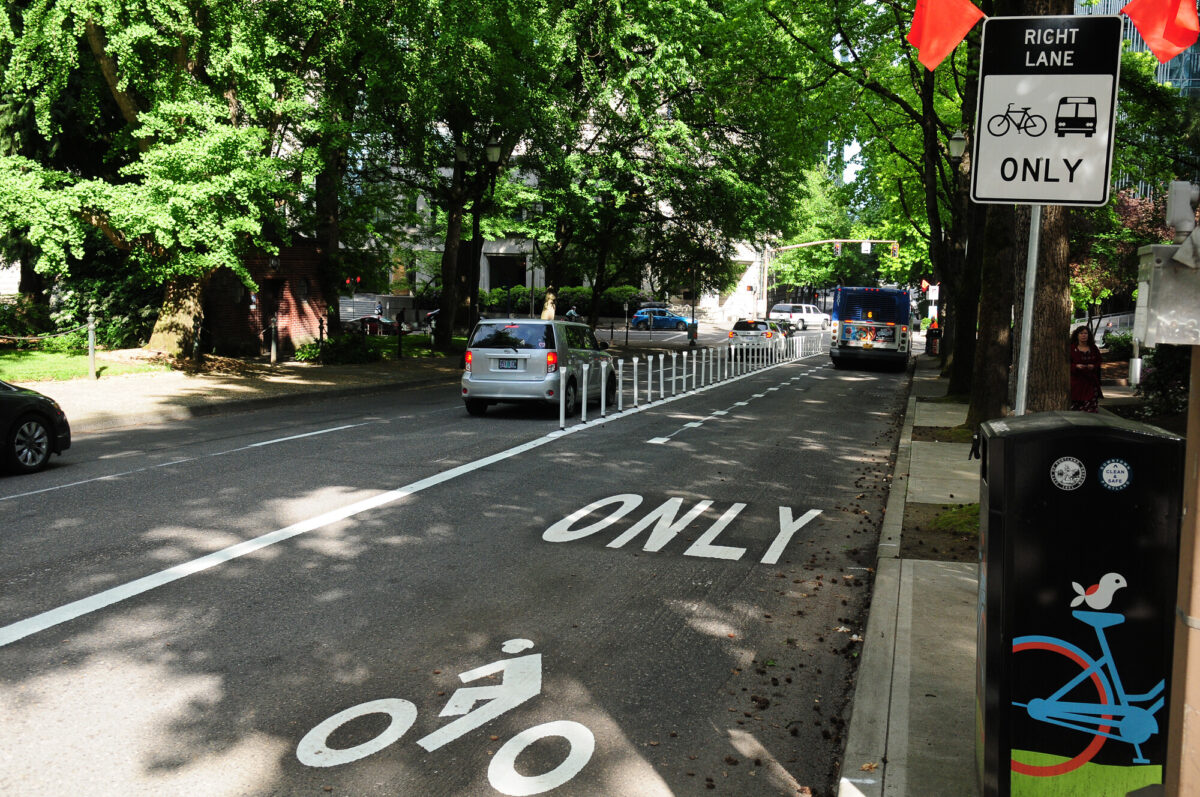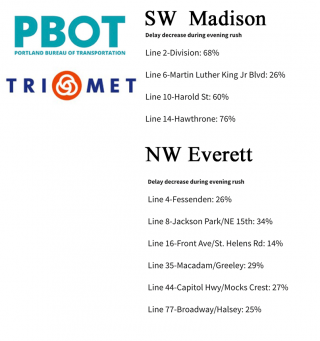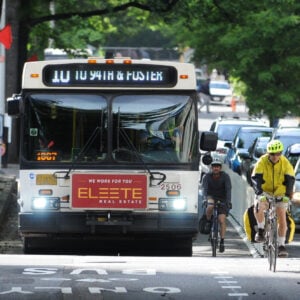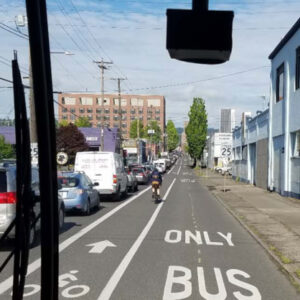
(Photo © J. Maus/BikePortland)
Amid all the talk about how to “fix congestion” there’s one cheap and relatively simple solution staring us in the face: dedicated lanes for efficient vehicles like bikes and buses.
Six months ago Portland unveiled our first significant dedicated bus/bike lane on SW Madison. Despite being only four blocks long, TriMet data shows the project has had significant positive impacts on bus speeds. According to data released this week, lines 2, 6, 10 and 14 have seen a decrease in delay during the evening rush by 68%, 26%, 60%, and 76% respectively.
On NW Everett between 5th Avenue and the Steel Bridge, TriMet’s Line 4 had seen a 14% average speed decrease in the last 10 years. A bus lane project completed back in August has resulted in a significant decrease in delays — between 25% and 34% — for five of the six lines that use the street. On TriMet’s Line 8, the new lane cut evening commute travel time by more than a minute and a half.
The 10 lines on Madison and Everett serve about 50,000 trips per day and the time savings downtown have a ripple effect throughout the system.
Advertisement
PBOT Project Manager Gabriel Graff shared at Portland City Council last week that the latest bus-only lane on Burnside should have similarly positive impacts.
While road widening projects can cost hundreds of millions of dollars, what’s notable about these recent bus/bike lane projects is how inexpensive they are. The SW Madison project cost just $160,000. The city’s cost estimate for creating 5,500 feet (about one mile) of red painted priority lanes is just $200,000.
While some policymakers think the answer to congestion is to give users of the least efficient vehicles — cars and trucks — more room to operate, expensive lane and freeway-widening projects never have this much return-on-investment.
Advertisement
That’s why PBOT, City Hall and TriMet plan to keep the momentum going. Last week the City of Portland accepted $3.14 million from TriMet as part of a grant to fund their ongoing partnership on these and future lane redistribution projects. These initial successes are also key to building political and public will for the recently launched Rose Lane Project. (To learn more about what’s coming, attend one of the three Rose Lane Project open houses early next month.)
These successes have me thinking: If this works so well for crowded central city streets, wouldn’t it work even better on crowded interstates and state highways? Hopefully the Oregon Department of Transportation is taking notice of these projects. Who knows, maybe someday soon they’ll pilot a dedicated bus rapid transit lane on a nearby freeway. I’ll put that one on my Christmas list!
— Jonathan Maus: (503) 706-8804, @jonathan_maus on Twitter and jonathan@bikeportland.org
— Get our headlines delivered to your inbox.
— Support this independent community media outlet with a one-time contribution or monthly subscription.







Thanks for reading.
BikePortland has served this community with independent community journalism since 2005. We rely on subscriptions from readers like you to survive. Your financial support is vital in keeping this valuable resource alive and well.
Please subscribe today to strengthen and expand our work.
I have added it to my christmas list as well. Remember when Novick made a list? https://www.portlandoregon.gov/transportation/article/474350
Despite Novick’s list, one of the first things he did (along with Hales) was to gut dedicated active transportation funding. This resulted in the cancellation of the east portland 4M project and the cancellation of the complete build out of the 100s neighborhood greenways. And 6 years later, neither of those projects have been completed. Moreover, Novick and Hales’ laser focus on fixing pot holes and paving streets helped add enormous fuel to the bikelash fire.
Pay attention to what democrats do, not what they say.
“Pay attention to what democrats do, not what they say.”
This is why I am an Independent.
What kind of metric is “decrease in delay”? I wish Trimet/PBOT could be a bit more specific in what this means. Is it a decrease in the number of delays (more continuous movement) or a decrease in the length of delays (still in traffic overall, but now less long because of this segment). Are the buses running 1 minute faster during rush hour? Did ridership increase after these improvements? I wish they could get a better PR person to sell these results more clearly.
True ^^^ I wish they would say if the buses are staying more on schedule. Maybe include some metrics about emissions and roadway maintenance costs (less stops = less pavement wear)
I applaud the city’s finally coming up with a way to help transit, motorists, and bicyclists to more-safely co-exist. Although my blog has in the past blasted some bicyclists’ dangerous antics, the vast majority of you ride safely and with the mindset of ‘sharing the road’ including being seen and predictable. Thank you for making a bus operator’s job easier.
However, a few who use transit AND ride have a few lessons yet to learn. Here, I describe my recent interaction with one who leads with disrespect for one who truly watches out for our two-wheeled road warriors.
https://fromthedriverside.blogspot.com/2019/11/fools-insult-me-yet-insult-themselves.html?showComment=1574950421141#c6187018767599187757
Decrease in delay usually means a reduction in total cumulative delay over “freeflow” times; how that delay is distributed (“chunky” or “smooth”) is a different matter altogether.
Because they talk so much about time and speed in the article I’m left to assume it’s mostly a decrease in the length of delays, but that probably also means a decrease in the number of delays.
Would be nice if they linked to the actual data because nerds.
This is a metric that measures cumulative delay, how far behind the bus is compared to the free-flow schedule. AFAIK this is an internationally accepted metric.
A percentage increase in delay was also the story line used by the freight community to argue against restriping the St. John’s Bridge from four lanes to three. Percentage increase in delay wasn’t a valid metric for that argument and the supposed decrease in delay isn’t for the bus lanes.
What we really need to know is how it changes total travel time, reliability (schedule compliance), and ridership.
All too often, using percentages is a way to disguise what’s really happening.
Yes, because the number one thing I care about when I step on the bus is how long it’s going to take me to get to my stop. Can you imagine a dedicated lane up and down Powell.
My dream is that one day these will be everywhere in town and that those that travel in them (cyclists and transit riders) will be bestowed with high social status and admiration from all. Those still crawling along in the ” congestion lanes” will aspire to adjust their lifestyles and achieve a worthy goal.
^^^ Comment of the week^^^
They could easily put shared carpool/bus lanes on all the major commute highways. We shouldn’t be on a bus sitting in car traffic.
This suggestion (HOV lanes on all major freeways) is standard practice in the Seattle area and Bay Area. It’s a no brainer. But for some reason Portland officials have never followed suit. And it’s also weirdly missing from the tolling proposals now being considered. Why??
Totally agree. Go to Washington DC area and see how HOV lanes work. But one word of caution:
In some places (NYC metro area), HOV lanes were built as trojan horses for freeway widening: accept the funding for the HOV lane and later remove the HOV designation when authorities decided the HOV lane “wasn’t working.”
It’s true that HOV lanes are standard in places like Seattle. It’s also true that those lanes are so generous in their definition of HOV (two people in a car, or a motorcycle) that they pack up during rush hour. I’ve spent a heck of a lot of time in traffic on a Sound Transit bus in an HOV lane that should be a bit more demanding (HOV 3+) so it actually works as an incentive.
It’s my understanding (from a Ctran driver) that the Portland area has tried HOV lanes in the past but failed to enforce them, so only the bit on i-5 remains. From this 2012 Oregonian article linked in my name, they only tried the nb one on i-5 and (Wa-to-Or) commuters put up such a stink and failed to use it as designed, so that WA gave up.
This is good news and I hope to see a more in-depth report once the facilities have been in use for 6 months to a year. [I hope CTRAN is keeping an eye on this effort by TRIMET since CTRAN has gone out of its way to do the opposite with its BRT projects (by not having dedicated lanes).
A bus without exclusive ROW is not BRT.
And wow, they actually did it without taking away a driving lane. They took away parking lanes. That’s something I can actually get behind.
Trimet needs to market a free week/month on the buses to get commuters to who were horribly let down in the past to try it again and realize what’s happening.
It’s still not clear to me whether or not we’re allowed to ride bikes in the bus-only segment of NW Everett. Has there been any official word on that?
I hear you. I asked PBOT to clarify this issue. Here’s what I heard back:
That is an excellent meaningless response I’ll need to remember for future transportation planning job interviews.
It’s been a fascinating to see folk who previously professed committment to all-ages/all-abilities cycling infrastructure do a 180 and celebrate infrastructure that requires people biking to ride in close proximity to 30 ton buses.
It’s called a state-imposed “complete-streets” policy: You put in a painted 6-foot bike lane on a posted 45 mph arterial roadway where traffic is moving at 55 mph, and bicyclists 8 to 80 are used as speed devices to slow traffic down to the posted speed limited. It’s a reverse-engineered bike lane. I’ve have met many engineers, planners, and bicycle advocates here in NC who really do believe in all this crap, I’m not making it up. Obviously even the bicycle advocates drive cars everywhere, even to bike advocacy conferences.
I cycle NW Everett daily and I have yet to see a cyclist, including myself, ride in the car lane like Gabe would suggest.
Who the heck is Luke Everett??
A parallel relative of NEd Flanders, related by marriage to NEe Davis?
Jonathan, I appreciate your readers who are constantly aware of their surroundings. They recognize the dangers of interacting with our buses and other vehicles. Proper hand signals have considerable value to professional drivers. Those who do not read your blog are those who are the most dangerous because they are the least-aware of the dangers surrounding them.
Thank you for your insight and knowledge, and safe cycling to all you who read this blog. It’s invaluable to Portland bicycle safety, and I salute you.
Respectfully,
Deke N. Blue
Transit Blogger/Author
It’s great to see data showing the investment is getting the intended results and I appreciate the projects were ‘cheap and easy’ relative to what we’ve come to expect from bureaucracies like PDOT and TriMet. Still, painting a four block stripe and installing 100 plastic wands cost 160k and painting a 5,500 foot lane cost 200k, or $4.50/sqft. My hope is that these early projects can serve as a template and be scaled at an even lower cost.
From talking with our engineers here in NC, the biggest cost comes from removing the old lines, a process typically referred to as “scratching”, as in erasing the lines. When a street is ground down for repaving, the scratching cost is zero. Adding in either painted or thermal plastic lines are typically minimal in cost, unless the street surface is “etched” with a groove for the thermal plastic, in case of snow plowing later on. Another significant cost is that of design and public outreach, which here in NC is minor as no one comes to public meetings, but in Portland can be significant, as you know very well.
This lane on Madison is such a boon for transit and yet so simple. Only wish it had been implemented sooner. Hard to take away lanes from areas where congestion is already def-con 5 and not expect some raised voices. Time to act now in other areas where delay are likely to intensify. Huge swaths of East Portland are in need of transit-priority during PM rush.
This sounds good, as far as it goes. However transit riders are moving outside 205 and 217 because of increasing housing prices close in.
https://transitcenter.org/in-portland-economic-displacement-may-be-a-driver-of-transit-ridership-loss/
Transit lanes need to start happening 5 miles from downtown as well. How about express bus lines that serve distant neighborhoods and then switch to transfer stops only?
I like the 2 blocks on Madison that have the shared lane. The problem is getting to those 2 blocks from the Park blocks/Broadway can be difficult during rush hours. If I leave work after 5, I often find it quicker to hop on the sidewalk and slowly roll to those 2 blocks of shared lanes; Madison itself is chocked with traffic. As a former east-coast city commuter, I’m comfortable with squeezing through locked traffic, but sometimes Madison is too tight.
All of these bus lanes should be bus only. The idea that mixing bike traffic with bus traffic will encourage people to bike more is absurd (and not supported by the repeated failure of these types of facilities to encourage cycling elsewhere).
I don’t know what happens elsewhere. What I’ve seen in Portland is that humans will use open space if it’s not positively dangerous (full of large fast moving vehicles) or subject to vigorous rule enforcement, either by traffic police, ha! or TriMet bird dogs in SUVs. This applies equally to people on foot, on bikes or scooters, drivers of private cars, and vehicles for hire not having taxi plates.
The success of sharing with buses will depend on their frequency, their speed, and the width of the lane. I believe that a transit operator with a makable schedule and a carfree lane for 100 blocks is more likely to play nice with bike riders. I’d like to see a street design with spots for bike riders to hold up and let the bus past, and buses equipped with a bell or beeper as well as a horn.
If shared BUS/bike lanes are the new gold standard for cycling then why would PBOT dedicate any more money to cycling infrastructure in these areas in the future?
Purely a technical question, but how do you get bold letters to show up on this blog?
The bold tag:
https://www.w3schools.com/tags/tag_b.asp
I’m not against dedicated cycling infrastructure which I think is what you are making a stand for. However the common run of ‘bike infrastructure’ projects in Portland make me feel about the I way would feel if somebody else were chewing my food for me.
Those lanes are mostly empty. What a waste of a car lane. PDX hates cars that pay for the roads. Makes no sense to me.
“Those lanes are mostly empty. What a waste of a car lane. PDX hates cars that pay for the roads. Makes no sense to me.”
For one, they don’t pay for the roads completely. But they also INCREASE the cost of the roads, and are the lease efficient form of transport using them in the city. Not to mention the increase of cost of health care, insurance, groceries, property tax/rent, and more that the fees associated with cars don’t pay for in general.
It’s actually more responsible of PDX to develop a system that will move more people efficiently and will cost less in the long term, along with the savings for the city/residents for potentially fewer auto collisions (with the associated crash cleanup, medical costs, missed work days, etc.).
Also, can’t remember where I saw it, but there was a video from somewhere else (possibly London?) that countered the view from angry motorists that a car-free lane was a waste because it was empty most of the time. Thing was, that lane moved just as many (if not more) people* per hour than the multiple car lanes next to it, but since it flowed freely instead of being packed with cars it made it look like there were few people using it. These lanes in Portland aren’t likely moving as many people and are currently underutilized, but that has more to do with the patchwork way PDX is implementing them. Once they’re built out more and have better connections they’ll likely be moving a lot more people*, even if they still don’t appear to be.
* Notice I say “people” and not “vehicles”. The “T” in PBOT stands for Transportation, not Cars. Imagine how long it would take to move 30 cars through one of those lanes and the amount of blocks they’d be stretched out for. The days I ride the bus to work there are easily 30+ people on with me, all taking up the same space of road as 2-3 cars.
I suspect that “decrease in delay” was a larger number than “increase in speed” or some other metric. It sounded better, so they used it.
Too bad their ‘cheap and easy’ bikeway network isn’t working out nearly as well…
Which one ?
I asked trimet what metric they were using to calculate the percentage decreases in delay noted in this article and was told I would need to make a public records request through their legal department to get that information. Seems weird that they won’t just explain how they are calculating the numbers in their press release. I didn’t particularly think it was a gotcha question but the response makes me wonder what is up.
I’m reasonably sure that nothing is up, beyond better trying to track time and route requests to the staff best able to answer them. I made a request to TriMet a few weeks ago, and they responded promptly with the information I wanted. Try it, and report back.
hahahaha aha
Miserable earthling, “make a public records request through (my) legal department”
No bike lanes in front of city hall, still a race track. Bus lanes? I don’t know..does a bus go by the front door? Is there a bulb out for pedestrians? Bus lanes are great. Because really, you aren’t going to change the bad kids in class (which in this case are the single car drivers), you have to make a way for the good kids (bus lanes). So it’s great. But when will city hall take the real first step?
The Madison lane didn’t appear to be working well when I rode in it a few days ago. The bike portion of the lane next to the bollards was buried in a deep layer of leaves, while the bus portion was clear.
Unfortunately PBOT maintenance seems to have no automated mechanism for clearing these areas where they need to be swept. However, I have found if I call 503-823-1700 (PBOT Maintenance) and request sweeping of a PBOT roadway it will usually be done within a day or two. If everyone who wanted a PBOT lane cleared called 503-823-1700 a couple more times a year our streets would be clearer. As much as I hate being forced to share the leftovers with other modes I definitely prefer the shared bus/bike lane treatment to mixing it up with unpredictable single occupancy drivers. Keep the bus lanes coming.